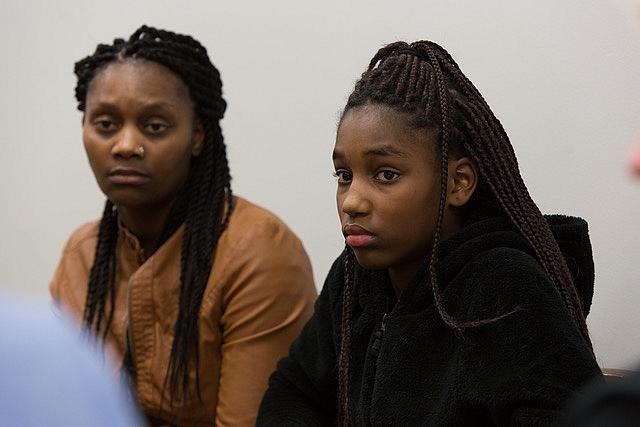Kentucky disproportionately locks up black youth, and few seem to care

Connie White, left, and her daughter, Lataevia Gaskin, listen during a Restorative Justice Louisville meeting in January 2018. (Photo by J. Tyler Franklin)
In Louisville, black youth comprise less than 27 percent of the population.
But they are more than 75 percent of the youth in lockup.
That number fluctuates a little, year to year. But for the better part of this decade, the vast majority of the young people checked into the city’s secure detention facility have been black. This unequal ratio existed before law enforcement and youth advocates agreed to work together to figure out a solution, convening monthly meetings and taking harder looks at the data. Despite their efforts, it has remained true in the years since.
This is not only an issue in Kentucky’s largest city. My reporting found that the pattern extends into small cities and even rural areas throughout the state, with disparities at nearly every step in the juvenile justice process. From who gets arrested to who serves time, black youth consistently see worse outcomes. Research by the Sentencing Project shows that your state probably has some racial disparities in its juvenile justice system, too.
I first learned about this issue while researching a major piece of new legislation that would drastically reduce the number of youth who entered the justice system. The reform, which went into effect in 2014, also kept fewer minor offenders out of lockup. But soon after the reform kicked in, a side effect began to appear: the racial disparity was getting worse.
I thought I’d be able to access lots of data that would help me figure out the extent of this issue, and that was where I hit my first roadblock. It turned out many of the state’s agencies dealing with youth don’t have systems that speak to each other, and even they can’t see the whole picture of what happens to an individual. There is no central record for a teen in foster care who also has open court cases, and since two different agencies manage those issues, case managers are responsible for keeping track of details that never make it into spreadsheets.
The next problem was confidentiality: Even when I asked for data with all identifying information removed, I still faced resistance. Instead, I was offered only statistics. This was limiting, and frustrating. But I was not the only person in the state who was interested in this. My story began to move forward once I found researchers who had already gotten access to and analyzed the data I sought.
These were the same researchers who were raising the alarm on worsening disparities, and their important work had been going largely unnoticed by the media for years. They were glad to help me understand their findings, point me to other studies and to help me put them all in the larger context of the system — a system that appears to keep black youth from the opportunities white youth receive — the opportunities they might need to move past juvenile offenses and become productive adults.
The next struggle I faced was finding affected youth. Since their names were protected, I wasn’t able to check court cases. Advocates are understandably hesitant to put their clients in the spotlight. But through some programs in the justice system and public defenders, I was able to find teens and families willing to share their struggles.
The most surprising thing I learned through this process is how infrequently the people — by that I really mean white people — in my community are talking about this issue.
There is a small and dedicated circle of advocates here. They all know each other, participate in task forces together and often come together to find resources for a struggling family. They felt validated, and heard, by my stories, and I know some young people and their families must have, too. But honestly, even in the wake of my reporting, I am still not sure how much of this type of reporting is preaching to the choir. The people who spoke about and shared these stories most are the people who already know about the problem.
The predominantly black community of families affected by this issue already know it, because they live it. The predominantly white population, far less burdened by juvenile incarceration, hears it and goes about its business. We held an hour-long call-in special on WFPL News, and despite poignant conversation, shocking statistics and an overwhelming problem that needs to be solved, we didn’t receive a single call.
I think the answer to what feels like apathy is more coverage. As an investigative reporter who has long focused on criminal justice issues, I get a steady flow of information about crime and punishment, about the ways in which our systems discriminate against minorities. I get it because I seek it out. We will see more people care about this issue when they realize it’s not going away until a whole community comes together to do something about it.

